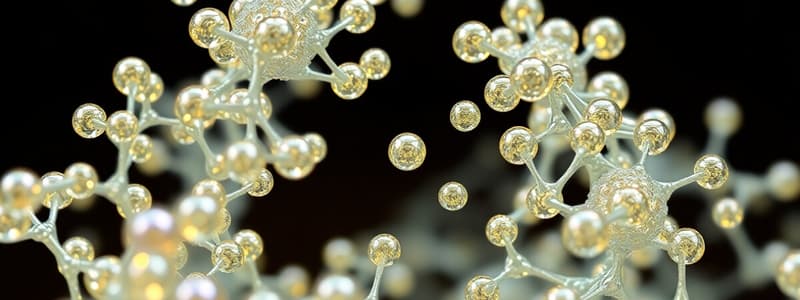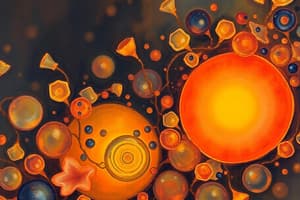Podcast
Questions and Answers
What characterizes a compound lipid in terms of its components?
What characterizes a compound lipid in terms of its components?
- It is a conjugate of lipids and non-lipid groups. (correct)
- It is formed exclusively from nucleic acids.
- It consists solely of fatty acids and glycerol.
- It contains only lipid molecules.
Which of the following correctly identifies the components of a phospholipid?
Which of the following correctly identifies the components of a phospholipid?
- Three fatty acids and a phosphate group.
- Two fatty acids and a carbohydrate.
- A lipid part and a phosphoric acid part. (correct)
- One fatty acid and a nitrogenous base.
Which type of compound lipid includes a carbohydrate component?
Which type of compound lipid includes a carbohydrate component?
- Glycolipids (correct)
- Sulpholipids
- Lipoproteins
- Phospholipids
What is a distinguishing feature of lipoproteins?
What is a distinguishing feature of lipoproteins?
Which of the following items is NOT a component of phospholipids?
Which of the following items is NOT a component of phospholipids?
What type of compound lipid includes sulphate in its structure?
What type of compound lipid includes sulphate in its structure?
Which of the following correctly describes the structure of a glycolipid?
Which of the following correctly describes the structure of a glycolipid?
Which of the following is a primary function of phospholipids?
Which of the following is a primary function of phospholipids?
Which lipoprotein is primarily responsible for transporting dietary triglycerides from the small intestine to peripheral tissues?
Which lipoprotein is primarily responsible for transporting dietary triglycerides from the small intestine to peripheral tissues?
What is the primary composition of High Density Lipoprotein (HDL)?
What is the primary composition of High Density Lipoprotein (HDL)?
Where are Very Low Density Lipoproteins (VLDL) primarily synthesized?
Where are Very Low Density Lipoproteins (VLDL) primarily synthesized?
Which type of lipoprotein is responsible for transporting endogenous triglycerides?
Which type of lipoprotein is responsible for transporting endogenous triglycerides?
What percentage of lipid is found in Low Density Lipoprotein (LDL)?
What percentage of lipid is found in Low Density Lipoprotein (LDL)?
Lipoproteins are formed by the binding of lipids to which type of molecules to enhance their solubility in blood?
Lipoproteins are formed by the binding of lipids to which type of molecules to enhance their solubility in blood?
High Density Lipoproteins (HDL) are primarily involved in the transport of which substance?
High Density Lipoproteins (HDL) are primarily involved in the transport of which substance?
What is the primary role of phosphatidyl inositol in cellular membranes?
What is the primary role of phosphatidyl inositol in cellular membranes?
Which phospholipid is predominantly found in the myelin sheath of nerves?
Which phospholipid is predominantly found in the myelin sheath of nerves?
Which component is NOT typically found in the structure of phospholipids?
Which component is NOT typically found in the structure of phospholipids?
What is the main nitrogenous base associated with lecithin?
What is the main nitrogenous base associated with lecithin?
Which type of phospholipid is primarily derived from sphingosine?
Which type of phospholipid is primarily derived from sphingosine?
Which phospholipid is most abundant in cellular membranes?
Which phospholipid is most abundant in cellular membranes?
What type of alcohol is ethanolamine classified as in phospholipid structure?
What type of alcohol is ethanolamine classified as in phospholipid structure?
Which phospholipid primarily aids in cell signaling pathways?
Which phospholipid primarily aids in cell signaling pathways?
What is the function of cephalin in the cell membranes?
What is the function of cephalin in the cell membranes?
Which component is derived from glucose in phospholipid structures?
Which component is derived from glucose in phospholipid structures?
Which compound is essential for the process of blood clotting?
Which compound is essential for the process of blood clotting?
What effect does lung surfactant have on the alveoli?
What effect does lung surfactant have on the alveoli?
Which of the following is a type of glycolipid found particularly in nervous tissues?
Which of the following is a type of glycolipid found particularly in nervous tissues?
Which lipid structure does not contain a nitrogenous base?
Which lipid structure does not contain a nitrogenous base?
What condition may result from a deficiency in lung surfactant?
What condition may result from a deficiency in lung surfactant?
Which glycolipid is primarily found in brain and nervous tissue?
Which glycolipid is primarily found in brain and nervous tissue?
What type of fatty acid is associated with sphingosine in the structure of glycolipids?
What type of fatty acid is associated with sphingosine in the structure of glycolipids?
What two components make up glucosyl ceramide?
What two components make up glucosyl ceramide?
Which sugar units can be part of a cerebroside structure?
Which sugar units can be part of a cerebroside structure?
What happens when there is a failure in the degradation of complex lipids in the CNS?
What happens when there is a failure in the degradation of complex lipids in the CNS?
What component primarily makes up the structure of lipoproteins?
What component primarily makes up the structure of lipoproteins?
What is the primary function of lipotropic factors in the liver?
What is the primary function of lipotropic factors in the liver?
What is a key role of sphingolipids in the body?
What is a key role of sphingolipids in the body?
What characterizes sulfolipids?
What characterizes sulfolipids?
In what way do glycolipids differ from phospholipids?
In what way do glycolipids differ from phospholipids?
Which of the following is NOT a function of lipoproteins?
Which of the following is NOT a function of lipoproteins?
Which of the following is considered a major simple glycosphingolipid of extra neural tissues?
Which of the following is considered a major simple glycosphingolipid of extra neural tissues?
What is the fate of a lipid molecule if it lacks a conjugated protein in lipoprotein?
What is the fate of a lipid molecule if it lacks a conjugated protein in lipoprotein?
Which compound is primarily used in the formation of gangliosides?
Which compound is primarily used in the formation of gangliosides?
Which type of lipid plays an essential role in the membranes of nervous tissue?
Which type of lipid plays an essential role in the membranes of nervous tissue?
Flashcards
Compound Lipids
Compound Lipids
Lipids combined with non-lipid molecules.
Phospholipids
Phospholipids
Compound lipids with phosphoric acid.
Glycolipids
Glycolipids
Compound lipids with carbohydrates.
Sulpholipids
Sulpholipids
Signup and view all the flashcards
Lipoproteins
Lipoproteins
Signup and view all the flashcards
Phospholipid Structure
Phospholipid Structure
Signup and view all the flashcards
Phospholipid Alcohol
Phospholipid Alcohol
Signup and view all the flashcards
Phosphatidic Acid
Phosphatidic Acid
Signup and view all the flashcards
Phospholipids (PLs)
Phospholipids (PLs)
Signup and view all the flashcards
Lecithin
Lecithin
Signup and view all the flashcards
Cephalin
Cephalin
Signup and view all the flashcards
Sphingomyelins
Sphingomyelins
Signup and view all the flashcards
Phosphatidylcholine
Phosphatidylcholine
Signup and view all the flashcards
Phosphatidyl ethanolamine
Phosphatidyl ethanolamine
Signup and view all the flashcards
Cell membrane
Cell membrane
Signup and view all the flashcards
Myelin sheath
Myelin sheath
Signup and view all the flashcards
Phosphatidyl inositol
Phosphatidyl inositol
Signup and view all the flashcards
Nitrogenous base
Nitrogenous base
Signup and view all the flashcards
Hormone action
Hormone action
Signup and view all the flashcards
Lipotropic factors
Lipotropic factors
Signup and view all the flashcards
Lung surfactant function
Lung surfactant function
Signup and view all the flashcards
Respiratory distress syndrome (RDS)
Respiratory distress syndrome (RDS)
Signup and view all the flashcards
Glycolipids structure
Glycolipids structure
Signup and view all the flashcards
Cerebrosides
Cerebrosides
Signup and view all the flashcards
Sphingosine-ceramide
Sphingosine-ceramide
Signup and view all the flashcards
Glycolipids distribution
Glycolipids distribution
Signup and view all the flashcards
Phospholipids: Nitrogenous base absence
Phospholipids: Nitrogenous base absence
Signup and view all the flashcards
Blood clotting
Blood clotting
Signup and view all the flashcards
What is a glycolipid?
What is a glycolipid?
Signup and view all the flashcards
What is the main glycolipid in the brain?
What is the main glycolipid in the brain?
Signup and view all the flashcards
What is the main glycolipid in other tissues?
What is the main glycolipid in other tissues?
Signup and view all the flashcards
What are sulfolipids?
What are sulfolipids?
Signup and view all the flashcards
Why are complex lipids important?
Why are complex lipids important?
Signup and view all the flashcards
What happens if complex lipids can't be degraded?
What happens if complex lipids can't be degraded?
Signup and view all the flashcards
What are lipoproteins?
What are lipoproteins?
Signup and view all the flashcards
Why are lipoproteins soluble?
Why are lipoproteins soluble?
Signup and view all the flashcards
What are the parts of a lipoprotein?
What are the parts of a lipoprotein?
Signup and view all the flashcards
What are the functions of lipoproteins?
What are the functions of lipoproteins?
Signup and view all the flashcards
Lipid transport in blood
Lipid transport in blood
Signup and view all the flashcards
Chylomicrons (CM)
Chylomicrons (CM)
Signup and view all the flashcards
Very Low Density Lipoprotein (VLDL)
Very Low Density Lipoprotein (VLDL)
Signup and view all the flashcards
Low Density Lipoprotein (LDL)
Low Density Lipoprotein (LDL)
Signup and view all the flashcards
High Density Lipoprotein (HDL)
High Density Lipoprotein (HDL)
Signup and view all the flashcards
Key difference between LDL and HDL
Key difference between LDL and HDL
Signup and view all the flashcards
Study Notes
Lipid Chemistry - Lecture 2: Compound Lipids
- Compound lipids are lipids conjugated with non-lipids (other groups)
- Examples of compound lipids include phospholipids, glycolipids, sulfolipids, and lipoproteins
Types of Compound Lipids
-
1. Phospholipids (PLs):
- Composed of a lipid part (e.g., fatty acids, alcohol) and a non-lipid part (e.g., phosphoric acid, nitrogenous base).
- Phosphatidic acid is a crucial component
- Common nitrogenous bases include choline, ethanolamine, and serine.
-
2. Glycolipids:
- Composed of a lipid part (e.g., fatty acids, sphingosine) and a carbohydrate part.
- Ceramide is a common lipid component.
- Common carbohydrates include glucose and galactose.
- Cerebrosides are a type of glycolipid found in brain and nerve tissue
- Galactosyl ceramide is a major glycolipid in the brain and other nerve tissues.
- Glucosyl ceramide is a major glycosphingolipid in extra-neural tissues.
-
3. Sulfolipids (Sulfatides):
- Formed by attaching sulfate groups to ceramide oligosaccharides.
- Crucial components of nervous tissue membranes.
- Failure in the degradation of sulfolipids can lead to their accumulation in the Central Nervous System (CNS).
-
4. Lipoproteins:
- Composed of lipids and proteins.
- The proteins (apoproteins) make lipids water-soluble, allowing transport in the blood.
- Types include chylomicrons, VLDL, LDL, and HDL, each with different roles in lipid transport and function.
Structure of Phospholipids
- Consist of a lipid part (fatty acids) and non-lipid part (phosphoric acid and nitrogenous base).
Functions of Lipoproteins
- Crucial for transporting lipids in the blood
- Help make lipids water-soluble
- Important in cell membrane structure
- Types include chylomicrons, VLDL, LDL, and HDL
Functions of Each Type of Lipoprotein
- Chylomicrons (CM): Transport dietary triglycerides from the small intestine to peripheral tissues.
- Very Low-Density Lipoprotein (VLDL): Transport endogenous triglycerides (produced in the liver) to peripheral tissues.
- Low-Density Lipoprotein (LDL): Transports cholesterol from the liver to peripheral tissues.
- High-Density Lipoprotein (HDL): Transports cholesterol from peripheral tissues back to the liver (reverse cholesterol transport).
Summary of Compound Lipids
- Each type of compound lipid has a specific function in transporting lipids, participating in cell membrane structure, and carrying out other physiological processes.
Studying That Suits You
Use AI to generate personalized quizzes and flashcards to suit your learning preferences.
Related Documents
Description
Dive into the fascinating world of compound lipids in this quiz. Explore the structures and types, including phospholipids, glycolipids, and sulfolipids. Test your knowledge on their components and functions in biological systems.





